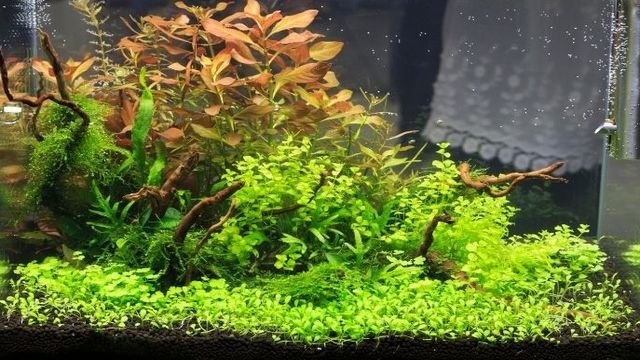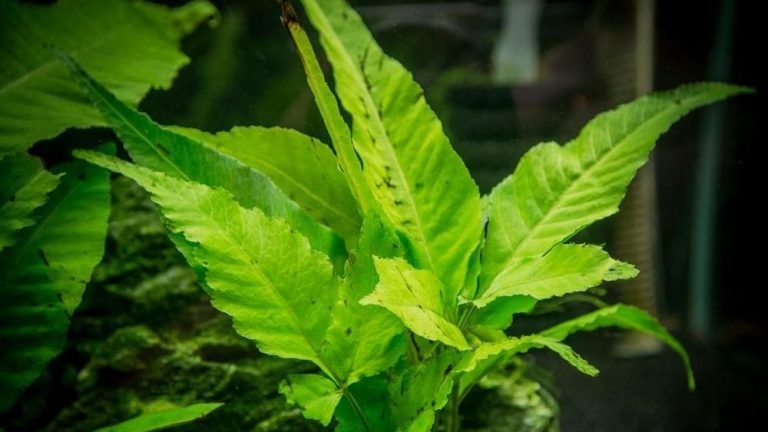Tissue Culture Aquarium Plants
As an avid aquarium enthusiast, I have always sought out innovative ways to enhance the beauty of my underwater world. One method that has caught my attention is the use of tissue culture aquarium plants.
These remarkable plants offer numerous benefits, from their ability to grow quickly and adapt to various tank conditions to their disease-free nature. In this article, I will explore how tissue culture plants are produced, provide tips for choosing the right ones, and offer advice on successfully introducing them into your tank.
Key Takeaways
- Tissue culture plants are genetically identical copies of plants produced in a laboratory using tissue culture techniques.
- They are grown in sterile conditions, ensuring they are free from pests, diseases, and algae.
- Tissue culture plants offer improved plant health as they are free from pests, diseases, and algae.
- Tissue culture plants are cost-effective in the long run due to their durability and resistance to diseases.
What Are Tissue Culture Aquarium Plants
Tissue culture aquarium plants are genetically identical copies of plants that are produced in a laboratory using a process called tissue culture. This method involves taking a small piece of plant tissue, such as a leaf or stem, and placing it in a sterile nutrient medium. Under controlled conditions, the tissue will grow and develop into a whole plant.
One of the advantages of tissue culture plants is their uniformity. Since they’re genetically identical, they exhibit consistent growth patterns and characteristics. This is particularly beneficial in aquariums, where a cohesive and harmonious appearance is desired. Additionally, tissue culture plants are free from pests, diseases, and algae. They’re grown in sterile conditions, ensuring that no unwanted organisms are introduced into the aquarium ecosystem.
However, there are some common misconceptions about tissue culture plants. Some people believe that they aren’t as hardy as traditionally grown plants. This isn’t true. Tissue culture plants can thrive in a variety of aquarium conditions, as long as their basic requirements for light, nutrients, and water quality are met. Another misconception is that tissue culture plants are more expensive. While they may have a higher initial cost, their long-term benefits, such as their durability and resistance to diseases, make them a cost-effective choice.
Benefits of Using Tissue Culture Plants
Using tissue culture plants in my aquarium has numerous advantages. These plants, which are grown in a controlled laboratory setting, offer several benefits over traditional, potted aquarium plants.
Improved Plant Health – Tissue culture plants are free from pests, diseases, and algae, ensuring a healthier aquarium environment. Their sterile nature eliminates the risk of introducing harmful organisms into the tank.
These plants are also grown under optimal conditions, resulting in vigorous growth and vibrant colors. They’re free from any nutrient deficiencies commonly found in potted plants.
Easy Maintenance
Tissue culture plants are delivered in a gel-like substance that provides essential nutrients to the plants. This eliminates the need for additional fertilizers initially and simplifies the maintenance process.
Due to their small size, tissue culture plants can be easily planted in the aquarium substrate, creating a seamless and natural-looking layout. Their compact form also reduces the need for frequent pruning.
How Tissue Culture Plants Are Produced
To produce tissue culture plants, a laboratory cultivates cells or tissues of the desired plant species in a controlled environment. This process involves the use of tissue culture techniques, which allow for the propagation of plants with desirable traits.
The first step in producing tissue culture plants is selecting a suitable plant specimen. It’s important to choose a healthy plant with distinct characteristics that can be replicated through tissue culture. Once the plant is selected, a small sample, such as a leaf or stem, is taken and sterilized to eliminate any potential contaminants.
The sterilized sample is then placed onto a nutrient-rich agar medium containing a mix of essential nutrients, vitamins, and growth regulators. Under controlled conditions of temperature, light, and humidity, the cells in the sample begin to divide and form a mass of undifferentiated cells called a callus.
This callus is then transferred to a different medium that promotes the growth of shoots or roots. Eventually, individual plantlets are obtained, which can be transplanted into soil or grown in an aquatic environment. Through these tissue culture techniques, laboratories are able to efficiently produce large quantities of genetically identical plants, allowing for the rapid propagation of aquarium plants with desired traits.
Choosing the Right Tissue Culture Plants for Your Aquarium
I often choose tissue culture plants for my aquarium based on their compatibility, growth rate, and visual appeal. Tissue culture plants offer a convenient and efficient way to introduce new plants into my aquarium.
Here are two key factors I consider when selecting tissue culture plants for my aquarium:
Compatibility: It’s crucial to choose tissue culture plants that are compatible with the existing inhabitants of the aquarium. This includes considering factors such as water parameters, lighting requirements, and the type of substrate in the tank. By selecting plants that thrive in similar conditions as the current inhabitants, I can ensure a harmonious and balanced ecosystem.
Growth Rate: Another important aspect to consider is the growth rate of the tissue culture plants. Some plants may grow rapidly, while others may have a slower growth rate. By choosing plants with varying growth rates, I can create a visually appealing aquascape with layers and textures, as well as prevent overcrowding.
It is important to note that there are common misconceptions about tissue culture plants. Contrary to popular belief, tissue culture plants aren’t inherently inferior to traditionally grown plants. In fact, tissue culture plants are often free from pests and diseases, making them a healthier option for my aquarium. Additionally, tissue culture plants are grown in a sterile environment, ensuring that they’re free from unwanted contaminants.
Tips for Successfully Introducing Tissue Culture Plants to Your Tank
When introducing tissue culture plants to my aquarium, I follow these tips for a successful transition.
Tissue culture plants offer numerous benefits in aquascaping, including the absence of pests, diseases, and algae.
To ensure a smooth introduction, it’s important to first prepare the tank by cleaning the substrate, removing any dead or decaying matter, and ensuring proper water parameters.
Next, gently remove the tissue culture plants from their containers, being careful not to damage the delicate roots. Rinse the plants thoroughly to remove any residual gel or media.
It’s crucial to acclimate the plants to the tank environment by gradually introducing them to the water, preferably by floating them in a plastic bag. This allows the temperature and water chemistry to adjust slowly, reducing the risk of shock.
Once acclimated, carefully plant the tissue culture plants in the substrate, ensuring the roots are properly covered. Provide adequate lighting and nutrient-rich water to promote healthy growth.
Regular monitoring and maintenance, such as trimming and fertilizing, will help the tissue culture plants thrive in your tank.
Maintaining and Caring for Tissue Culture Aquarium Plants
Proper maintenance and care are essential for ensuring the health and longevity of tissue culture aquarium plants. To effectively care for these plants and promote their growth, it’s important to follow these guidelines:
Water Quality – Maintain a pH level between 6.5 and 7.5 to create optimal conditions for plant propagation. Regularly test and adjust the water hardness to ensure it falls within the suitable range for the specific plant species.
Lighting – Provide appropriate lighting conditions based on the requirements of the tissue culture plants in your aquarium. Consider using a timer to regulate the lighting duration and mimic natural day and night cycles.
Nutrient Supply – Supplement the aquarium water with essential nutrients, such as nitrogen, phosphorus, and potassium, to support plant growth. Consider using fertilizers specifically formulated for aquatic plants, as they contain the necessary elements in appropriate proportions.
Algae Control – Monitor and control the growth of algae in your aquarium, as excessive algae can compete with tissue culture plants for resources. Regularly clean the tank, remove any decaying organic matter, and consider introducing algae-eating species to help maintain a balanced ecosystem.
By carefully attending to water quality, lighting, nutrient supply, and algae control, you can ensure the overall health and well-being of your tissue culture aquarium plants.
Following these guidelines will promote successful plant propagation and enhance the beauty of your aquarium.
Frequently Asked Questions
How Long Do Tissue Culture Aquarium Plants Typically Last in a Tank?
In my experience, tissue culture aquarium plants typically last for a considerable amount of time in a tank. The longevity of these plants is one of the advantages of using tissue culture plants in aquariums.
Can Tissue Culture Plants Be Mixed With Regular Aquarium Plants?
Yes, tissue culture plants can be mixed with regular aquarium plants. However, it’s important to consider their different needs and growth rates. Tissue culture plants offer precise control, while regular plants add natural diversity to the tank.
Are Tissue Culture Plants Safe for All Types of Fish and Invertebrates?
Yes, tissue culture plants can be safe for all types of fish and invertebrates. However, it’s important to consider compatibility concerns for delicate invertebrates. The benefits of using tissue culture plants include their disease-free nature, while drawbacks may include higher cost.
Can Tissue Culture Plants Be Used in Both Freshwater and Saltwater Aquariums?
Yes, tissue culture plants can be used in both freshwater and saltwater aquariums. They offer numerous benefits in aquascaping, such as their precise propagation methods and ability to enhance the overall aesthetic of the tank.
Are There Any Specific Requirements for Lighting or Water Parameters When Using Tissue Culture Plants in an Aquarium?
There are specific lighting requirements and water parameter guidelines to consider when using tissue culture plants in an aquarium. It is important to provide adequate light and maintain appropriate water conditions for the plants to thrive.
Conclusion
In conclusion, tissue culture aquarium plants offer a convenient and efficient way to enhance the beauty of your tank. With their numerous benefits and ease of maintenance, these plants are a must-have for any aquarium enthusiast.
By following the proper guidelines for selection and introduction, you can ensure the success of your tissue culture plants.
So dive into the world of tissue culture and watch your aquarium thrive with scientific precision and a touch of whimsical charm.

